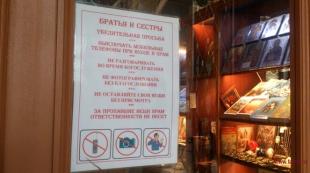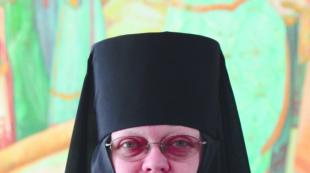Peter and Fevronia are symbols of family happiness. About Peter and Fevronia. Peter and Fevronia died on the same day

Why did they begin to be revered as the patrons of marriage? This “trick question” is asked not only by atheists - believers are also sometimes surprised: “They may even be childless!” And the non-believers frolic, sometimes to their heart's content. One well-known politician and journalist not so long ago made a sarcastic comment, calling Fevronia a blackmailer and Peter weak-willed. Of course, with a malicious conclusion: a strange role model for modern families.
But reductio ad absurdum is a good, visual method of argumentation. And the author, accusing Saint Fevronia of blackmail, involuntarily highlighted for me the reasons why Saints Peter and Fevronia can really be a model, and precisely in our days.
In fact, it is extremely important for us that saints marry without being saints at all. Peter - whatever one may say - lied to Fevronia. Fevronia “didn’t miss hers.” There is a pious interpretation of her behavior: the future princess supposedly saw with her spiritual eye that the prince would die without her influence, and that’s why she began to set conditions, and did not heal the prince just like that...
But, oddly enough, for modern young spouses it is much more useful to accept the idea that the noble prince and princess were indeed people not without shortcomings during their youth. But they forgave each other for these shortcomings, covered them with love - and their love blossomed to the point of readiness to renounce fame and honor for the sake of their beloved.
After all, we are now simply thoroughly marinated with ideas about the impeccability, the ideality of everything that we can “let in” into our lives. Modern freedom in choosing a life partner plays a cruel joke on people. It seems: since you are no longer bound by the authority of your parents and class barriers (and some are not bound by moral taboos), you can choose a spouse for yourself, just like a jacket “fits.” Try on half the store and find the best one, so that there are no flaws at all.
Somewhere at the level of words, a person seems to understand that “everyone has shortcomings,” but deep down in his soul he hopes that he will definitely be lucky, because he is smarter than others! And then six months pass (a year, five years...), and the young husband or wife exclaims: “Yes, everyone has shortcomings, but LIKE THIS!” And try someone standing next to you to object that “nothing special, nothing deadly, you’re not much of an angel either”!
Often only very bitter experience convinces a person that everyone really has shortcomings - and very serious ones. And they don’t die from them, but even live happily ever after if they understand in time how to deal with someone else’s shortcomings.
How do many spouses traditionally deal with each other's shortcomings? Mothers, girlfriends/boyfriends run to announce them out loud, or even trust their VKontakte status - why waste time on trifles... And they themselves peer deeper into these weaknesses and shortcomings, analyze, mentally weigh and structure... Until they convince themselves that everything is “time to get a divorce” "...
The spouses are like two warriors with unpatched chain mail on their backs in battle against the temptations of this world. They can stand back to back in defense - and they will survive. Or they can start spinning around, looking at each other’s backs with arrogant laughter: “Well, come on! How did you get ready to fight like this, you idiot?!” It is unlikely that they will laugh for a long time.
Marital fidelity, among other things, is expressed in striving to cover up the infirmities of the other half not only from prying eyes, but also from one’s own irritability. We are not talking about some grave sins that destroy a marriage in principle, but specifically about weaknesses. Laziness, carelessness or excessive pedantry, hot temper or emotional dryness - you can quite get along with them until you start making mountains out of molehills. Well, my husband came in, tired and out of sorts. How difficult it is for a wife to bear this calmly! Do not start to “unwind” your spouse’s temper with reproaches and questions, but wait until it goes away on its own.
How difficult it is to protect a loved one from our own nagging and reproaches... How easy it is to fall into irritability and scrupulously study other people's shortcomings through a fragment from the mirror of a troll, who, as you remember, “was the devil himself.”
During their marriage, Prince Peter and Princess Fevronia very quickly learned to “stand back to back,” covering each other’s weaknesses from the world and their own infirmities. And they showed us that this path is fruitful, that weaknesses are not forever. And forever - only love. We just need to save it...
Peter and Fevronia of Murom are Russian Orthodox saints who are revered as patrons of family and marriage. Their marriage is considered exemplary in Orthodoxy. The Holy Blessed Prince Peter, in monasticism David, and the Holy Blessed Princess Fevronia, in monasticism Euphrosyne, Murom miracle workers. The blessed Prince Peter was the second son of Murom Prince Yuri Vladimirovich. He ascended the Murom throne in 1203. A few years earlier, Saint Peter fell ill with leprosy, from which no one could cure him. In a dream vision, it was revealed to the prince that he could be healed by the beekeeper’s daughter, the pious maiden Fevronia, a peasant woman from the village of Laskovoy in the Ryazan land. Saint Peter sent his people to that village. When the prince saw Saint Fevronia, he fell in love with her so much for her piety, wisdom and kindness that he vowed to marry her after healing. Saint Febronia healed the prince and married him. The holy spouses carried love for each other through all trials. The proud boyars did not want to have a princess of ordinary rank and demanded that the prince let her go. Saint Peter refused and the couple were expelled. They sailed on a boat along the Oka River from their hometown. Saint Febronia supported and consoled Saint Peter. But soon the city of Murom suffered the wrath of God, and the people demanded that the prince return along with Saint Fevronia. The holy spouses became famous for their piety and mercy. They died on the same day and hour, June 25, 1228, having previously taken monastic vows with the names David and Euphrosyne. The bodies of the saints were laid in one coffin. There is another version of this story. It is stated by D. S. Likhachev as follows: “The heroine of the story is the maiden Fevronia. She is wise with folk wisdom. She makes wise riddles and knows how to resolve life's difficulties without fuss. She does not object to her enemies and does not insult them with open teaching, but resorts to allegory, the purpose of which is to teach a harmless lesson: her opponents themselves realize their mistakes. She works miracles in passing: she makes the branches stuck for the fire bloom into a large tree overnight. Her life-giving power extends to everything around her. Crumbs of bread in her palm turn into grains of fragrant incense. Prince Peter tries to deceive her only once, at the beginning, when he decides not to marry her, contrary to his promise. But after the very first lesson taught to him by Fevronia, he listens to her in everything and, having got married, lives with her in harmony, their love crosses the threshold of death.” The essence of this story, apparently, is the same. Which of them was in reality is unknown, since the Tale of Peter and Fevronia was recorded by the Chronicler Ermolai the Pregreshny by order of Metropolitan Macarius in the 16th century. Peter and Fevronia were canonized in 1547. Saints' Day of Remembrance is June 25 (July 8, New Style).
July 8(June 25 according to the Julian calendar) The Russian Orthodox Church honors the memory of the Murom holy spouses Peter and Fevronia, who lived at the turn of the 12th-13th centuries. Their marriage is a model of Christian marriage. Saints Peter and Fevronia were revered in Rus' as the patrons of married life; It was believed that with their prayers they brought down heavenly blessings on those entering into marriage.
The life story of Peter and Fevronia existed for many centuries in the legends of the Murom land, where they lived and where their relics were preserved. Over time, real events acquired fabulous features, merging in people's memory with the legends and parables of this region. In the 16th century, the love story of Peter and Fevronia was described in detail and colorfully in the famous ancient Russian “The Tale of Peter and Fevronia” by a talented writer, widely known in the era of Ivan the Terrible, priest Ermolai the Prereshny (in monasticism Erasmus). Researchers argue about which of the historical figures the life was written about: some are inclined to think that it was Prince David and his wife Euphrosyne, monastically Peter and Fevronia, who died in 1228, others see them as the spouses Peter and Euphrosyne, who reigned in Murom in XIV century.
According to the Lives of the Saints, the blessed Prince Peter was the second son of Murom Prince Yuri Vladimirovich. He ascended the Murom throne in 1203. Several years before his reign, Peter fell ill with leprosy, from which no one could cure him. In a dream, it was revealed to the prince that he could be healed by the beekeeper’s daughter Fevronia, a peasant woman from the village of Laskovoy in the Ryazan land. Fevronia was beautiful, pious and kind, besides, she was a wise girl, she knew the properties of herbs and knew how to treat ailments, wild animals listened to her. The prince fell in love with Fevronia for her piety, wisdom and kindness and vowed to marry her after healing. The girl healed the prince, but he did not keep his word. The illness resumed, Fevronia again cured the prince, and he married the healer.
After the death of his brother, Peter inherited the reign. The boyars respected their prince, but the arrogant boyar wives disliked Fevronia, not wanting to have a peasant woman as their ruler. The boyars demanded that the prince leave her. Peter, having learned that they wanted to separate him from his beloved wife, chose to voluntarily renounce power and wealth and go into exile with her. Peter and Fevronia left Murom, sailing on a boat along the Oka River. Soon, unrest began in Murom, the boyars quarreled, seeking the vacated princely throne, and blood was shed. Then the boyars, who came to their senses, gathered a council and decided to call Prince Peter back. The prince and princess returned, and Fevronia managed to earn the love of the townspeople. They ruled happily ever after.
In their old age, Peter and Fevronia took monastic vows in different monasteries with the names David and Euphrosyne, and prayed to God that they would die on the same day, and bequeathed themselves to be buried together in a specially prepared coffin with a thin partition in the middle.
They each died in their own cell on the same day and hour - July 8 (Old Style - June 25) 1228.
People considered it impious to bury monks in one coffin and violated the will of the deceased: their bodies were placed in different monasteries. However, the very next day they ended up together. Twice their bodies were carried to different temples, but twice they miraculously found themselves nearby. So they buried the holy spouses together in the city of Murom near the Cathedral Church of the Nativity of the Blessed Virgin Mary.
Approximately 300 years after their death, Peter and Fevronia were canonized by the Russian Orthodox Church. Now the relics of Saints Peter and Fevronia rest in the Holy Trinity Convent in Murom.
On this day, it is customary for Orthodox believers, first of all, to visit churches. In their prayers, young people ask God for great love, and older people ask for family harmony. The day of Peter and Fevronia is popularly considered lucky for love. Also, according to popular belief, from this day you should wait for forty hot days.
On March 26, 2008, at a meeting of the Federation Council Committee on Social Policy, the Federation Council unanimously approved the initiative to establish a new state holiday on July 8, the Day of the Patron Saints Peter and Fevronia - “All-Russian Day of Married Love and Family Happiness.” The first celebration will take place on July 8 this year in Murom, the homeland of Saints Peter and Fevronia.
Attention! Poll for women only! The men who joined him can be easily identified by their blue color!
The diaries sound perplexed: “What now - pick up an unwashed homeless person?”
Maybe so. When Prince Peter came to Fevronia for treatment, he hardly looked attractive and impressive. But the main thing is that it was still the prince whom Fevronia wanted to marry.
What was important to her? Why didn't she do the same to some man or soldier? We put the wealth, power and influence of the prince aside as an option: Fevronia easily endured the exile, and the attacks from the boyars towards her, a commoner, were not pleasant.
What motives drove this woman? Love for a handsome prince? How handsome he is when he arrived sickly... The fact that he is a hero, and women love heroes? Maybe so, but it’s unlikely that this was important for Fevronia.
The most precious thing that she herself voiced was her husband. And here comes the most important question for our ABC students: are you weak? Or will the husband come in second place after the cat, dog, child, mom and dad, apartment, car?
Is it hard to resist the temptation to play love with someone else’s warrior while your husband isn’t looking? And to whom did she say the words: “Scoop up water from the left side, and then from the right?” Fevronia probably knew the correct answer. And she didn’t say this to the warrior, but to herself - most likely! Today, in common language in swear words, it sounds something like this: “To change something for something is just a waste of time!” I hope it's clear what I mean?
The roles in the family of the prince and Fevronia were clearly distributed: he was involved in men's affairs, she was in charge of women's affairs. It is unlikely that Fevronia asked her husband to help her around the house, just as he did not invite her to think about issues of national importance (then the principalities were separate states). In general, everyone in the family specifically played their role. And, as we see, this was only beneficial for the family, and the mess usually begins where everyone starts to mind their own business: the wife teaches her husband how to drive a car, and he instructs her how to cook cabbage soup.
The spouses could not even imagine being without each other, or being next to someone. And this is the most important thing! This is the meaning of the question published below, the answer to which is important for those men who came to ABC to find a life partner. The opinion of the men reading this depends entirely on what women write in the comments! Well... and vice versa, of course! We are chosen, we choose... How often this does not coincide...
Once again I draw the attention of women: Fevronia was the first to invite Peter to marry her! The prince was probably stunned by such impudence, but... this was precisely what played a decisive role! So, dear ladies, are there any among you capable of such a feat?
And finally, are we, today's men and women, capable of loyalty, love, devotion to each other? Weak? Or how? Or, with a smartphone or laptop in hand, do we think that the appearance of spouses in the same coffin after death is a fake? Are we so lacking in faith that we consider this a fairy tale? Are there anyone here who believes in this - besides me?
Are we capable of continuing to love each other? When will we become wrinkled, gray, bald, thin or fat, unsuitable for sexual relations?
Why exactly Peter and Fevronia?
These saints are glorified by the Church not as saints, although they accepted the schema at the end of their lives, and not as martyrs and confessors, although they were expelled from their city. Fasting and prayer were part of their family life, and they were subjected to humiliation and danger for being faithful to each other. Saints Peter and Fevronia gave an example of an ideal Christian family. It is for this that they are awarded church veneration, which is why their life for more than eight centuries has served as an example of the proper attitude of spouses towards church marriage and towards each other.
The effectiveness of prayer to these saints, which the Church has been doing for 450 years, convinces us of the authenticity of the appearance of Peter and Fevronia, which was recreated by Ermolai-Erasmus in his “Tale”. They truly became the patrons of Christian marriage.
It is they who should pray for peace to be sent into the family, for strengthening marital ties, and for achieving family happiness. Thus, Saints Peter and Fevronia are included in the majestic picture of the Christianly understood history of the world; they are placed on a par with the apostles and martyrs and other great saints. And they were awarded such glorification “for the sake of courage and humility” that they showed in keeping the commandments of God regarding marriage. In this way they fulfilled their calling as Christians. This means that each of those who strive in Christian marriage and follow their example can be placed in this rank and can win the crown that Saints Peter and Fevronia of Murom were awarded.
Priest's comment
Archpriest Andrey Efanov:
“We know extremely little reliably about the life of Saints Peter and Fevronia. It is known that this princely couple lived in the 13th century, they had three children, they died on the same day, having accepted monasticism at the end of their life. As a one-of-a-kind exception, the prince and princess were buried in the same coffin.
Probably, it was precisely these circumstances of their lives that caused Saints Peter and Fevronia to become patrons of family and marriage. Indeed, what a beautiful ending to life, like in a fairy tale: “they lived happily ever after and died on the same day.” Which newlywed doesn’t dream of this?
However, such a death must still be earned. Raise wonderful children: patriotic sons, a daughter - the wife of the Grand Duke. Do not betray each other in times of trial, always stay together, in joy and sorrow. Firmly preserve the Orthodox faith. Only then can one hope for the mercy that was shown to the Murom saints.
There is a lot of beauty in the tale of Peter and Fevronia. I remembered the case when the prince’s hater wanted to separate him from his wife. However, the holy prince chose exile rather than be separated from his beloved wife. How many are now ready to follow the example of the saint?
Today, our society needs Family and Fidelity Day like air, like water. Marriages are being destroyed more easily than ever before; not everyone is ready to even remember about marital fidelity. But still, when getting married, most newlyweds dream of happiness, of love until death.
By choosing the Murom saints as patrons of their marriage, the newlyweds lay, albeit one, cornerstone in the foundation of their marriage. If the foundation of this house is strong faith, marital fidelity, love and mutual respect, if the children in this marriage are raised in Christian traditions, then nothing can destroy such a marriage. Any adversity, trial, or disaster can only shake such a house a little, but this will make each pebble fit even more tightly to the next one, and as a result, the house of such a marriage will only become stronger.
The Trinity Convent in Murom is not much different from other monasteries of this kind. But when you approach the relics of the wondrous Murom saints, all this is completely forgotten. Here the worshiper remains alone with Eternity. But alone does not mean alone.
TV story about celebrating the Day of Family, Love and Fidelity in Samara









